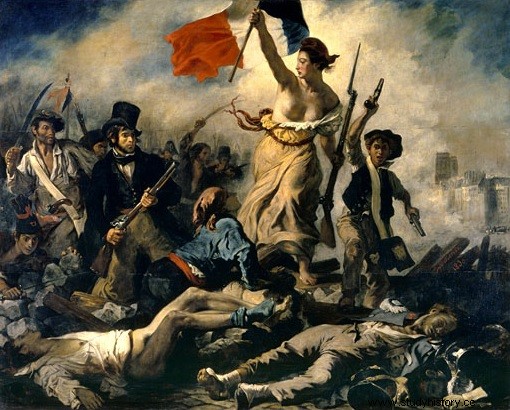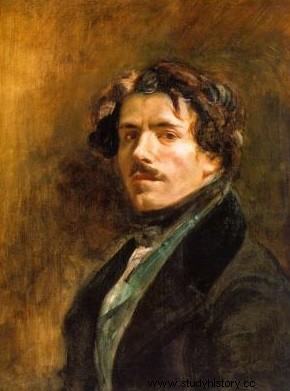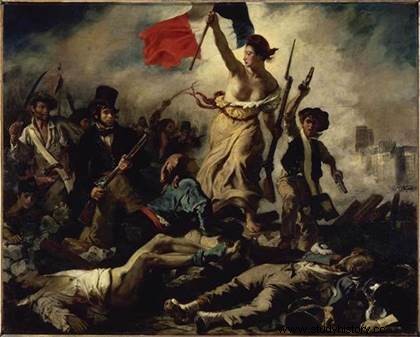 Oil painting on canvas, Freedom leading the people is a history painting by Frenchman Eugène Delacroix. For this painting, the artist was inspired by the three revolutionary days of July 1830, which culminated in the fall of the Bourbons and the coming to power of Louis-Philippe d'Orléans. Semi-allegorical glorification, Liberty leading the people was completed in 1830, and is kept in the Louvre Museum in Paris. With the realization of this work, Delacroix presents himself as a citizen artist who has fulfilled his duty to the Fatherland.
Oil painting on canvas, Freedom leading the people is a history painting by Frenchman Eugène Delacroix. For this painting, the artist was inspired by the three revolutionary days of July 1830, which culminated in the fall of the Bourbons and the coming to power of Louis-Philippe d'Orléans. Semi-allegorical glorification, Liberty leading the people was completed in 1830, and is kept in the Louvre Museum in Paris. With the realization of this work, Delacroix presents himself as a citizen artist who has fulfilled his duty to the Fatherland.
The painter Eugène Delacroix
Eugène Delacroix (1798-1863) was a French painter, member of the romantic movement. Eugène Delacroix trained with Théodore Géricault, the great master of romantic painting. Like him, he treats subjects with great passion and does not hesitate to express a certain violence in his paintings. Two of his best known paintings are the Scenes of the Massacres of Scio (1824) and the Death of Sardanapale (1827) which shocked the public of the time by the audacity of their colors and their composition. In 1830, Eugène Delacroix produced another masterpiece:Liberty leading the people .
 In 1832, he discovered Morocco during a trip. This discovery of oriental culture exerted a great influence on his art and inspired him to create many orientalist paintings and watercolors (such as Women of Algiers in their apartment, 1834). A great master of color, Eugène Delacroix is the author of numerous official commissions (decorations for the Louvre Museum in Paris). Friend of the writer Stendhal and the musician Frédéric Chopin, he left a Journal which offers valuable testimony to the art and life of his time.
In 1832, he discovered Morocco during a trip. This discovery of oriental culture exerted a great influence on his art and inspired him to create many orientalist paintings and watercolors (such as Women of Algiers in their apartment, 1834). A great master of color, Eugène Delacroix is the author of numerous official commissions (decorations for the Louvre Museum in Paris). Friend of the writer Stendhal and the musician Frédéric Chopin, he left a Journal which offers valuable testimony to the art and life of his time.
Considered as the leader of the romantic movement, passionate about freedom, appreciated by Charles X, friend of the Duchess of Berry and the d'Orléans, he nevertheless liked to hit the opinion. He wrote to his brother on October 28, 1830 “I have undertaken a modern subject, a barricade, and if I have not won for the fatherland, at least I will paint for it. It put me back in a good mood”.
Freedom leading the people
The fine-sized painting, two meters sixty by three meters twenty-five, was produced in the space of three months and completed in December 1830. Presented at the Salon of 1831, Louis Philippe buys it for three thousand francs in order to exhibit it at the Luxembourg Palace. It was finally transferred to the Louvre in 1874. This romantic and revolutionary painting is part of the historical painting of the 18th century. After the Ancien Régime, it is the renewal with the advent of Louis Philippe. The people explode with anger in the streets of Paris, the crowd crosses the barricades for its final assault on the opposing camp, led by Liberty!
Liberty, central and main character in the middle of the smoke of the cannons, is this young woman wearing the Phrygian cap, rebellious, the blue-white-red flag in her right hand , the rifle in the left hand, which involves the people and stimulates it for the victory. The bottom of the painting, strewn with corpses, soldiers who died during the battle, forms a pedestal on which the victor stands. At the foot of Liberty, a man in the color of the flag - blue vest, red scarf and white shirt - shot and bleeding, stands up at the sight of the young girl.
On the right, the kid from Paris, "a Gavroche" symbolizing rebellious youth, pistol in hand, arm raised, urges the insurgents to fight. On the far left, we can see a manufacturer with a beret, the white cockade of the monarchists and the red bow of the liberals. The man in the top hat seems to be a craftsman, bourgeois or townsman carrying a shotgun. The presence of this character is amazing in this painting, it could be that Delacroix painted himself here as if to approve this revolution.
In the smoke and darkness of the setting sun, we can see certain urban elements in the background:the barricades and Notre Dame…but everything seems distant compared to this battle and this victory!

Liberty Leading the People, by Eugène Delacroix, Louvre Museum.
To go further
- Eugene Delacroix, by Edwart Vignot. Victory Square, 2017.
- Historian's stories:Freedom guiding the people, by Francis Démier. Hatier, 2014.
